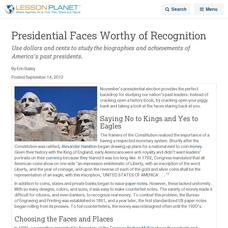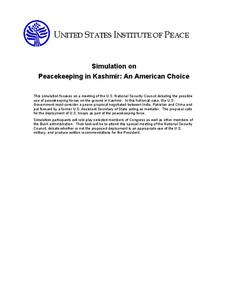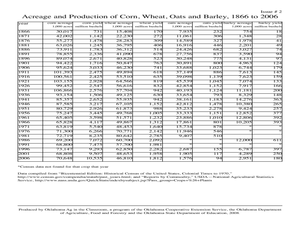Middle Tennessee State University
Who's Afraid of the Big Bad Wolf? A Comparison in American Culture
As part of their study of the Progressive Era, class groups examine a 20th century version of "The Three Little Pigs" through a New Era lens and identify how ideals such as the value of hard work, creativity, and problem solving,...
Curated OER
Presidential Faces Worthy of Recognition
Using dollars and cents to study the biographies and achievements of America's past presidents.
Bismarck Public Schools
Jefferson & the Louisiana Purchase
After learning about the Louisiana Purchase, assess your class members' understanding of Napoleon Bonaparte's involvement, states included in the purchase, and important key terms (i.e. neutrality, corps of discovery, etc.) associated...
Stanford University
Close Reading
Here's a poster that highlights the skills needed for the close reading of primary source documents when gathering evidence to support historical claims.
Metropolitan Museum of Art
Islamic Art and Geometric Design
After an overview of Islamic traditions and art, young artists create their own geometric shapes and patterns using only a straightedge and a compass.
International Debate Education Association
Speaking Across the Curriculum
With the focus on 21st century skills it is even more important that all teachers incorporate listening and speaking activities into their curriculum. Here's a packet of practical ideas appropriate for any classroom.
Teach Engineering
Earthquakes Living Lab: Geology and the 1906 San Francisco Earthquake
We can learn from the past to protect the future. Pairs look at two historical earthquakes: San Francisco, Calif., and Kobe, Japan. Pupils compare the two earthquakes and their impacts, then determine how engineers may use the...
US Institute of Peace
Simulation on Peacekeeping in Kashmir: An American Choice
Will the United States take a stand in the Kashmir conflict? A mock meeting of the minds examines a peace proposal between China, Pakistan, and India to determine if the United States should deploy troops to the area. Individuals take on...
University of California
The Civil War: Perspective
Confederate soldiers saw the Civil War much differently than their Union counterparts. Scholars analyze the perspective of the Civil War from the viewpoint of various key figures in the fourth installment of an eight-part series. By...
Stanford University
Migrant Mother Photograph
A picture often has hidden stories to tell. Looking at the iconic Migrant Mother photography by Dorothy Lange, individuals examine the human toll of the Dust Bowl and the Great Depression at large. Other documents, including a statement...
Curated OER
Bringing the Past to the Present
Second graders work in pairs and read a primary source artifact. They create a PowerPoint slide that will be part of a "museum" presentation for the rest of their class. Students select artifacts from a group of digitalized artifacts...
Curated OER
Government & Politics
In this United States history worksheet, students reference their textbook to answer 16 fill in the blank questions and 8 short answer questions regarding the early government of the nation.
Curated OER
Searching the THC Website
Learners use the internet to validate different websites. They examine the Texas Historical Commission's website and complete a question and answer section. They discuss the information they gathered with the class.
Curated OER
America Influenced by the Enlightenment
In this influence of the Enlightenment on America study guide worksheet, students read the notes provided and add notes of their own regarding the frameworks for the Declaration of Independence and U.S. Constitution.
Curated OER
3 Branches of Governement
Sixth graders use the "Making the Grade" books, citizenship packets, and the "Ben's Guide" website to create a poster and a report on their assigned government branch. They then present their poster and report to their classmates.
Curated OER
Surveying: 19 Chains and 50 Links
Through an interdisciplinary lesson, emerging engineers explore the history of surveying systems. After discussing various systems, they perform surveys on printable pages. Using their geometric skills, they physically stake out plots...
Curated OER
Slavery issue and view North versus South around 1850s
Students critique actions based on information from both sides of the argument. They analyze impact of slavery on both sides. Students recognize governmental attempts at pacifying the situation. They examine sources and critique them and...
Curated OER
Virtual Winter Count
Learn more about the North American Plains Indian tribes and their unusual methods of recording historical events. Learners examine the winter count, a custom by which these groups illustrated information after each winter passed. They...
Curated OER
Traditional Crafts and Decorative Arts in Louisiana Worksheet
This resource outlines an extensive list of websites about different kinds of material culture in Louisiana. The list covers five categories: outdoor and indoor crafts, Louisiana folk life articles, quilt making, house types, and general...
Curated OER
Revolutionary War Era Research Project
Young historians interpret historical evidence presented in primary and secondary resources in this American Revolution lesson. They select topics from the time era that they are interested in researching. Additionally, they follow...
Curated OER
George Washington and the First Census of Agriculture
Sixth graders compare modern agricultural statistics with those that are extracted from a primary source letter of George Washington. They complete worksheets and discuss what they have learned.
Curated OER
Nation Building
Ninth graders examine the role of the United States in nation building. In this World History activity, 9th graders evaluate the role of the United States in building nations in other parts of the world.
Education World
Every Day Edit - President Woodrow Wilson
In this everyday editing instructional activity, students correct grammatical mistakes in a short paragraph about President Woodrow Wilson. The errors range from capitalization, spelling, grammar, and punctuation.

























